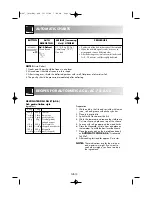
ENGLISH
GB-18
TIPS AND ADVICE
FATTY FOODS
Fatty meat and layers of fat cook better than lean
portions of meat. Before cooking, cover the fatty
portions with a piece of aluminium foil or place the
food with the fat side down.
BLANCHING VEGETABLES
Before freezing vegetables, they should be
blanched. This preserves the quality and flavour
at their best. Method: wash and chop the
vegetables. Put 250 g of vegetables in a dish with
275 ml water and cover. Heat for 3-5 minutes.
After blanching, immerse immediately in cold
water to prevent further cooking and then allow to
drain. Pack vegetables in an airtight container and
freeze.
PRESERVING FRUIT AND VEGETABLES
Using the microwave for preserving is quick and
easy. There are preserving jars,
rubber vacuum seals and suitable
seals made of plastic available
specially made for microwaves.
The manufacturers will supply precise instructions
for use.
LARGE AND SMALL QUANTITIES
Microwave times are directly dependent upon the
amount of food which you would like to thaw, heat
or cook. This means that small portions cook more
quickly than larger ones. As a rule of thumb:
TWICE THE AMOUNT = ALMOST TWICE THE TIME
HALF THE AMOUNT = HALF THE TIME
DEEP AND SHALLOW CONTAINERS
Both containers have the same capacity, but the
cooking time is longer for the deeper
one. You should therefore choose as
flat a container as possible with a
large surface area. Only use deep
containers for dishes where there is a danger of
overcooking, e.g. for noodles, rice, milk etc..
ROUND AND OVAL CONTAINERS
Food cooks more evenly in round or oval
containers than in containers with corners, since
the microwave energy concentrates in the corners
and the food in these areas could become
overcooked.
COVERING
Covering the food retains the moisture within it
and shortens the cooking time. Use
a lid, microwave foil or a cover.
Foods which are to be crispy, e.g.
roasts or chickens, should not be
covered. As a general rule, whatever would be
covered in a conventional oven should also be
covered in a microwave oven. Whatever would be
uncovered in an ordinary oven can also be left
uncovered in a microwave oven.
IRREGULAR SHAPED FOOD
Place the thicker, more compacted end of the food
pointing towards the outside. Place
vegetables (such as broccoli) with
the stalks pointing outward.
STIRRING
Stirring the food is necessar y, since the
microwaves begin by heating the
outer areas. The temperature is
thereby equalised and the food
heats up evenly.
ARRANGEMENT OF FOOD
Place a number of individual portions, such as
small pudding moulds, cups or potatoes in their
jackets, in a circle on the turntable. Keep the
portions at a distance from each other so that the
microwave energy can reach the food from all
sides.
TURNING
Medium-sized items, such as hamburgers and
steaks, should be turned over once during
cooking, in order to shorten the cooking process.
Large items, such as roasts and chickens, must be
turned, since the upper side receives more
microwave energy and could dry out if not turned.
STANDING TIME
Keeping to the standing time is one of the most
important rules with microwaves.
Almost all foods, which are thawed,
heated or cooked in the microwave,
require a certain amount of time to
stand, during which temperature equalisation takes
place and the moisture in the food is evenly
distributed.
R-647_[EN+Back CV].qxd 12/12/06 11:55 AM Page GB-19
















































